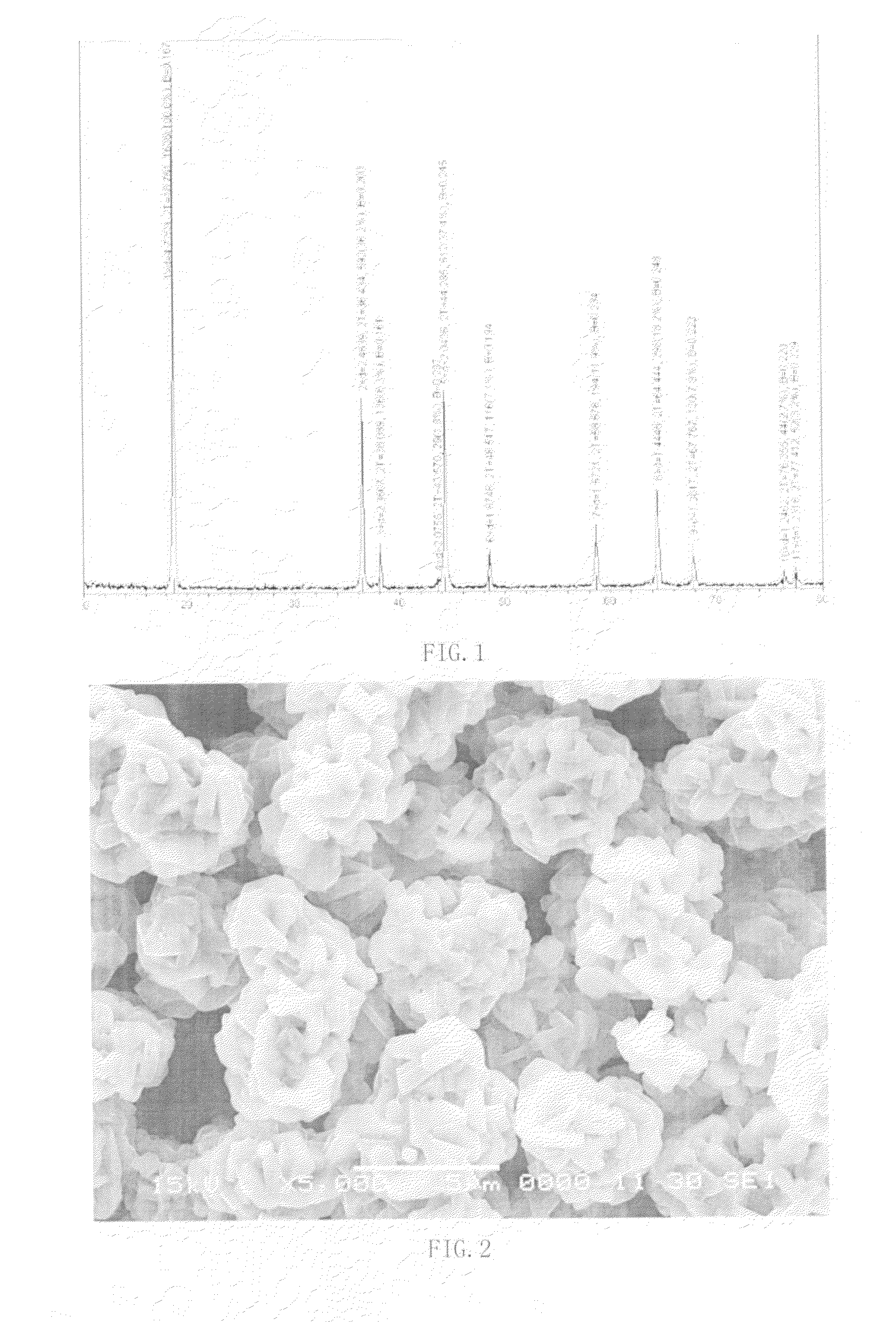High manganese polycrystalline anode material, preparation method thereof and dynamic lithium ion battery
- Summary
- Abstract
- Description
- Claims
- Application Information
AI Technical Summary
Benefits of technology
Problems solved by technology
Method used
Image
Examples
embodiment 1
[0056] provide 0.3 mol of Li element in Li2CO3, disperse in 300 ml aqueous colloid of 2% polyethylene glycol with a rotational speed of 50 rin / min and a time period of 10 min to form a colloid, obtain 0.1 mol nickel element in nickel carbonate and 0.8 mol manganese element in manganese carbonate and add into the colloid to mix uniformly with a speed of 60 rin / min for a time period of 10 min. Dry under 150° C. for 10 hours, grind and disperse by ball milling at a speed of 3000 rin / min for a time period of 2 min, obtain Li and Ni—Mn crystalline precursor 1.
[0057]Place the crystalline precursor under 850° C. for 7 hours. Cool naturally. Grind by ball milling until the particle size D50=12 micron. Obtain single crystalline compound A of LiMn2nNi2(1-n)O4, where n<1. As shown in FIG. 1, the lattice structure indicates a spinel structure. As shown in FIG. 2, it is a single crystalline structure.
embodiment 2
[0058] provide 1 mol of Li element in LiOH, disperse in 300 ml aqueous colloid of 5% polyethylene glycol with a rotational speed of 60 rin / min and a time period of 70 min to form a colloid, obtain 0.1 mol cobalt element in cobalt oxalate, 0.45 mol nickel in nickel oxalate and 0.45 mol manganese element in manganese oxalate and add into the colloid to mix uniformly with a speed of 50 rin / min for a time period of 10 min. Dry under 450° C. for 10 hours, grind and disperse by ball milling at a speed of 2500 rin / min for a time period of 10 min, obtain Li and Co—Ni—Mn crystalline precursor 2.
[0059]Homogenize the crystalline precursor 2 under 920° C. for 10 hours. Cool naturally to room temperature. Grind by ball milling until the particle size D50=18 micron. Obtain single crystalline compound B of LiCOn(NiMn)1-nO2, where n<1. As shown in FIG. 3, the lattice structure indicates a layered structure. As shown in FIG. 4, a single crystalline structure is shown.
embodiment 3
[0060] provide 0.3 mol of Li element in Li2CO3, disperse in 200 ml aqueous colloid of 4% polyethylene glycol with a rotational speed of 50 rin / min and a time period of 120 min to form a colloid, obtain 0.06 mol nickel element in nickel carbonate and 1.0 mol manganese element in manganese carbonate and add into the colloid to mix uniformly with a speed of 50 rin / min for a time period of 20 min. Dry under 250° C. for 10 hours, grind and disperse by ball milling at a speed of 2000 rin / min for a time period of 15 min, obtain Li and Ni—Mn crystalline precursor 3.
[0061]Homogenize the crystalline precursor 3 under 750° C. for 15 hours. Cool naturally to room temperature. Grind by ball milling until the particle size D50=8 micron. Obtain single crystalline compound B of LiMn2nNi2(1-n)O4, where n<1. As shown in FIG. 5, the lattice structure indicates a spinel structure. As shown in FIG. 6, it is a single crystalline structure.
PUM
 Login to View More
Login to View More Abstract
Description
Claims
Application Information
 Login to View More
Login to View More - R&D
- Intellectual Property
- Life Sciences
- Materials
- Tech Scout
- Unparalleled Data Quality
- Higher Quality Content
- 60% Fewer Hallucinations
Browse by: Latest US Patents, China's latest patents, Technical Efficacy Thesaurus, Application Domain, Technology Topic, Popular Technical Reports.
© 2025 PatSnap. All rights reserved.Legal|Privacy policy|Modern Slavery Act Transparency Statement|Sitemap|About US| Contact US: help@patsnap.com



